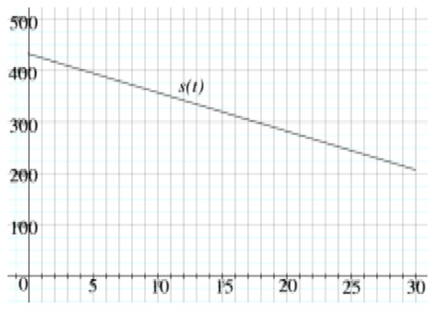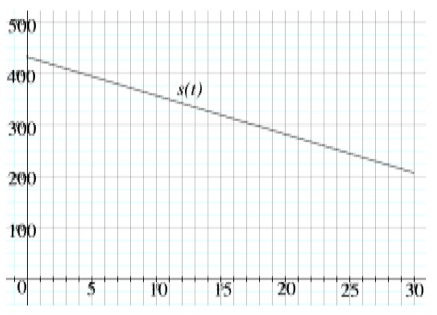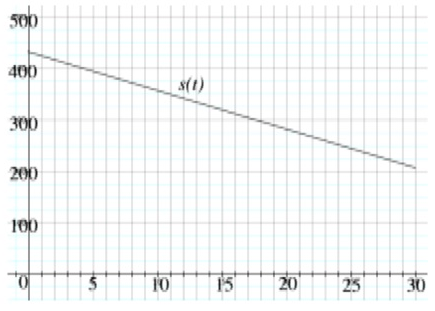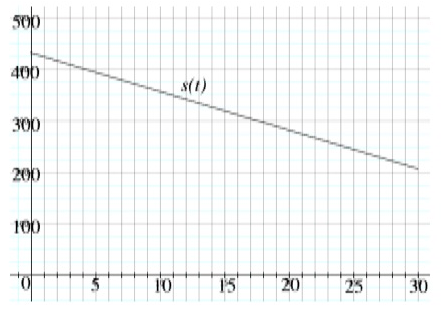Reference no: EM13999604
A meteor approaching the atmosphere was estimated to have a speed function of s(t) = 432 - 7.5t, where s is the speed in m / sec and time t is the time in seconds since the meteor was at a specified point in space.
The goal is to use the speed function to determine the distance traveled by the meteor in the first 30 seconds since the meteor was at the specified point. We will estimate this net change in distance using the speed function.
1) First estimate:
Use time intervals 10 seconds long. For each interval, assume a constant speed equal to the actual speed at the starting time (left side) of each interval.

1 a) Sketch, on the graph below, the function you'll be using to complete #1. (Based on set-up above)
1 b) Predict whether this estimate will lb) Predict whether this estimate will Explain why. (This has nothing to do with area!)
1 c) Use your pretend speed functions to approximate the distance traveled by the meteor in this 30 sec period.
2) Second estimate:
Use time intervals 10 seconds long. For each interval, assume a constant speed equal to the true speed at the ending time (right side) of each interval.

2 a) Sketch, on the graph below, the function you'll be using to complete #2. (Based on set-up above)
2 b) Predict whether this estimate will be an under-estimate or an over estimate.
2 c) Find an approximate distance traveled. Show work!
3) Third estimate:
Use time intervals 6 seconds long. For each interval, assume a constant speed equal to the actual speed at the starting time (left side) of each interval.

3 a) Sketch, on the graph below, the function you'll be using to complete #3. (Based on set-up above)
3b) Estimate the dist traveled. Show work!
4) Fourth estimate: (Read carefully!) Use 6 intervals, of equal time length. For each interval, assume a constant speed equal to the true speed at the ending time (right side) of each interval.

4 a) Sketch, on the graph below, the function you'll be using to complete #4. (based on set-up above)
4 b) Estimate the dist traveled. Show work!
5) Which of the four estimates is closest to the actual distance traveled by the meteor in 30 seconds? Explain your reasoning.
6) Write an expression using s (t) that represents the actual distance traveled by the meteor in the first 30 seconds:
7) Evaluate your expression using the Fundamental Theorem, to find the actual distance traveled. Show all work.
|
Under what circumstances would one be more advantageous
: Compare and contrast a sole proprietorship, a partnership and a corporation. Provide examples of where you would use each structure.
|
|
What is the y-component of the net force
: Three charges are positioned on the corners of a rectangle as shown with charge Q1 = -6.6μC, Q2 = +4.4μC, and q = -4.1μC. The side lengths of the rectangle are a = 12cm and b = 16cm . what is the x-component of the NET force on a due to both of th..
|
|
At what points will magnitude of his acceleration equal g
: A retired physics instructor is riding bulls at the rodeo to earn money. He is thrown upward at a forty degree angle. Assuming no air friction, at what points will the magnitude of his acceleration equal "g"?
|
|
The crash cost per day per activity
: When there are not enough resources available to fill all the needs in the project plan, what are some specific remedies a project manager can take to complete the project. How does each of these affect the project plan and performance?
|
|
Write an expression that represents actual distance traveled
: Write an expression using s (t) that represents the actual distance traveled by the meteor in the first 30 seconds: Evaluate your expression using the Fundamental Theorem, to find the actual distance traveled. Show all work.
|
|
Respond for business plan presentation
: Please detail up to five most contributions you made to the business plan and its preparation. Be as specific as possible, and where work was shared with another group member, please give details.
|
|
Calculate the net force f1 exerted on q1
: Consider charged particles Q1= 70.0 μC, Q2= 48.0 μC , Q3= -80.0 μC which are placed in a straight line along the x-axis. Q2 is placed in the center at a distance of 0.350 m from each of the others, and Q3 is also 0.350 m from some point P, as sh..
|
|
Briefly describe the pmis in your organization
: Good project communication starts with a communications plan. This document is sometimes overlooked because the project manager feels like he or she knows how, when, and what to communicate so that he or she does not need to take the time to docum..
|
|
Critique of the article - diagnostic delay in lung cancer
: Critique writing of the article - Diagnostic delay in lung cancer: a qualitative study
|